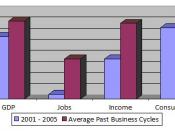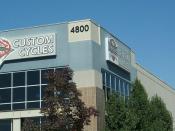Introduction.
The business cycle or economic cycle refers to the ups and downs seen somewhat simultaneously in most parts of an economy. The cycle involves shifts over time between periods of relatively rapid growth of output (recovery and prosperity), alternating with periods of relative stagnation or decline (contraction or recession). These fluctuations are often measured using the real gross domestic product.
To call those alternances "cycles" is rather misleading, as they don't tend to repeat at fairly regular time intervals. Most observers find that their lengths (from peak to peak, or from trough to trough) vary, so that cycles are not mechanical in their regularity. Since no two cycles are alike in their details, some economists dispute the existence of cycles and use the word "fluctuations" instead. Others see enough similarities between cycles that the cycle is a valid basis of studying the state of the economy. A key question is whether or not there are similar mechanisms that generate recessions and/or booms that exist in capitalist economies so that the dynamics that appear as a cycle will be seen again and again.
Just as there is no regularity in the timing of business cycles, there is no reason why cycles have to occur at all. The prevailing view among economists is that there is a level of economic activity, often referred to as full employment, at which the economy theoretically could stay forever. Full employment refers to a level of production at which all the inputs to the production process are being used, but not so intensively that they wear out, break down, or insist on higher wages and more vacations. If nothing disturbs the economy, the full-employment level of output, which naturally tends to grow as the population increases and new technologies are discovered, can be maintained forever.


